- Chess in the arts and literature
-
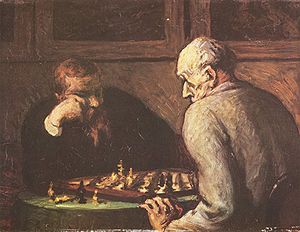 The Chess Players by Honoré Daumier (1863)
The Chess Players by Honoré Daumier (1863)
Chess became a source of inspiration in the arts in literature soon after the spread of the game to the Arab World and Europe in the Middle Ages. The earliest works of art centered around the game are miniatures in medieval manuscripts, as well as poems, which were often created with the purpose of describing the rules. After chess gained popularity in the 15th and 16th centuries, many works of art related to the game were created. One of the most well-known,[1] Marco Girolamo Vida's Scaccia ludus, written in 1527, made such an impression on the readers, that it single handedly inspired other authors to create poems about chess.[1]
In the 20th century, artists created many works related to the game, sometimes taking their inspiration from the life of famous players (Vladimir Nabokov in The Defense) or well-known games (Paul Anderson in Immortal Game, John Brunner in The Squares of the City). Some authors invented new chess variants in their works, such as stealth chess in Terry Pratchett's Discworld series or Tri-Dimensional chess in the Star Trek series.
Contents
History
10th to 18th century
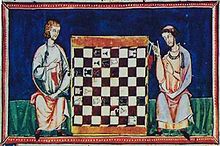 Some of the earliest examples of chess-related art are medieval illustrations accompanying books or manuscripts, such as this chess problem from the 1283 Libro de los juegos
Some of the earliest examples of chess-related art are medieval illustrations accompanying books or manuscripts, such as this chess problem from the 1283 Libro de los juegos
The earliest known reference to chess in a European text is a Medieval Latin poem, Versus de scachis. The oldest manuscript containing this poem has been given the estimated date of 997.[2] Other early examples include miniatures accompanying books. Some of them have high artistic value. The best known example is perhaps the 13th century Libro de los juegos. The book contains 151 illustrations, and while most of them are centered on the board, showing problems, the players and architectural settings are different in each picture.[3] The pieces illustrating chess problems in Luca Pacioli's manuscript De ludo scacchorum (Latin: On the Game of Chess) (c. 1500), described as "futuristic" even by today's standards,[4] may have been designed by Leonardo da Vinci.[4][5]
After chess became gradually more popular in Europe in the 15th and 16th centuries, especially in Spain and Italy, many artists began writing poems using chess as a theme.[6] Scachs d'amor (Catalan: Chess of love), written by an unknown artist in the end of the 15th century, describes a game between Mars and Venus, using chess as an allegory of love. The story also serves as a pretence to describe the rules of the game. De ludo scacchorum (unrelated to the manuscript menitoned above) by Francisco Bernardino Caldogno, also created at that time, is a collection of gameplay advice, presented in poetic fashion.[7][8]
One of the most influential[1] works of chess-related art is Marco Girolamo Vida's Scaccia ludus (1527), centered on a game played between Apollo and Mercury on Mount Olympus. It is said that, because of its high artistry, the poem made a great impression on anyone who read it, including Desiderius Erasmus.[1] It also directly inspired at least two other works.[9] The first is Jan Kochanowski's poem Chess (c. 1565), which describes the game as a battle between two armies, while the second is William Jones' Caissa, or the game of chess (1772). The latter poem popularised the pseudo-ancient Greek dryad Caïssa to be the "goddess of chess".[9]
19th century onwards
Since the 19th century, artists have been creating novels and – since the 20th century – films related to chess. Sometimes, they are inspired by famous games, like John Brunner's The Squares of the City, structured after the famous match between Wilhelm Steinitz and Mikhail Chigorin; Poul Anderson's short story Immortal Game, inspired by the 1851 game played by Adolf Anderssen and Lionel Kieseritzky (which also appears in the film Blade Runner); or Waldemar Łysiak's Szachista (Polish: The Chess Player), centered around a game played between Napoleon Bonaparte and The Turk. The game Frank Poole versus HAL 9000 from the film 2001: A Space Odyssey is also based on an actual match, albeit not widely known.[10]
Other artists drawn their inspirations from the life of players. Vladimir Nabokov wrote The Defense after learning about Curt von Bardeleben,[11] while the musical Chess was loosely based on the life of Bobby Fischer.[12] Some authors invented new chess variants in their works, such as stealth chess in Terry Pratchett's Discworld series or Tri-Dimensional chess in the Star Trek series.
One unusual connection between art and chess is the life of Marcel Duchamp, who almost fully suspended his artistic career to focus on chess in 1923.
In literature
Poems
- Versus de scachis (c. 997), earliest known reference to chess in a European text
- Scachs d'amor (Catalan: Chess of Love) (late 15th century). Describes a game between Mars and Venus
- De ludo scachorum (On the Game of Chess) (early 16th century) by Francisco Bernardino Caldogno. A collection of chess gameplay advice in poetic form
- Scaccia ludus (1527) by Marco Girolamo Vida. The poem describes a game of chess played by Apollo and Mercury on Mount Olympus
- Chess (c. 1565) by Jan Kochanowski. An epos parody which portrays a game of chess as a battle between two armies
- Caissa, or the game of chess (1772) by William Jones. Inspired by ancient Greek mythology, the poem tells the story of dryad Caissa, with whom Mars falls in love. In an attempt to win her heart, Mars asks the god of sport to create a gift for Caissa. The god creates the game of chess
- A Game of Chess, a section in The Waste Land (1922) by T. S. Eliot
- The Game of Chess included in Dreamtigers (1960), a poem (two sonnets) by Jorge Luis Borges
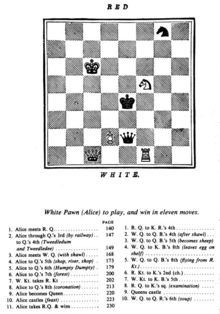 "White Pawn (Alice) to play, and win in eleven moves." Table of contents of Lewis Carroll's Through the Looking-Glass (1871)
"White Pawn (Alice) to play, and win in eleven moves." Table of contents of Lewis Carroll's Through the Looking-Glass (1871)
Novels
- Through the Looking-Glass, and What Alice Found There (1871) by Lewis Carroll. The book is chess-themed. Most main characters in the story are represented as chess pieces, with the main protagonist, Alice, being a pawn
- The Twelve Chairs (1928) by Ilf and Petrov, partially taking place at a chess club
- The Defense (1930) by Vladimir Nabokov. The main character, Aleksandr Luzhin, suffers from mental problems because of his obsession with chess
- The Royal Game (1942), a novella by Stefan Zweig
- All the King's Horses (1951) by Kurt Vonnegut, also included in Welcome to the Monkey House (1968)
- From Russia, with Love (1957) by Ian Fleming, part of the James Bond series. One of the villains, Tov Kronsteen, is a chess grand master who applies chess principles to espionage
- Forbidden Planet (1961) by Lionel Fanthorpe using the pseudonym John E. Muller, which describes an interstellar chess game played by superhuman entities using humans as pawns.
- The Squares of the City (1965), a science fiction novel by John Brunner, structured after the famous 1892 chess game between Wilhelm Steinitz and Mikhail Chigorin.
- Invisible Cities (1972) by Italo Calvino
- The Westing Game (1978) by Ellen Raskin
- Szachista (Polish: The Chess Player) (1980) by Waldemar Łysiak, centered around the game of chess between Napoleon Bonaparte and The Turk
- The Queen's Gambit (1983), a thriller novel by Walter Tevis. The main protagonist, Beth Harmon, is a chess player
- The Tower Struck By Lightning (1983) by Fernando Arrabal
- The Discworld series (since 1983) by Terry Prachett features a chess variant called Stealth Chess, which adds an assassin piece to the game. It is described in The Discworld Companion (1994)
- Unsound Variations (1987), a novella by George R. R. Martin included in Portraits of His Children
- The Eight (1988) by Katherine Neville. The main character, Catherine Velis, tries to recover the pieces of a chess set once owned by Charlemagne[8]
- The Joy Luck Club (1989) by Amy Tan
- The Flanders Panel (1990) by Arturo Pérez-Reverte, a chess-themed crime novel
- The Lüneberg Variation (1993) by Paolo Maurensig
- Harry Potter series (1997–2007) by J. K. Rowling. The series fictional universe features wizard's chess, a chess variant where the pieces are similar to living beings, to which the players give orders by voice
- Lord Loss (2005) by Darren Shan. The main character, Grubbs Grady, lives in a family of chess players
Short stories
- Striding Folly (1939) by Dorothy L. Sayers
- The Immortal Game (1954) by Poul Anderson, inspired by the 1851 game played by Adolf Anderssen and Lionel Kieseritzky
- Quarantine (1977), a short story by Arthur C. Clarke, about an extraterrestrial civilization which discovers chess after visiting Earth[13]
- Unicorn Variation (1983) by Roger Zelazny, included in Unicorn Variations
Comics
- Superman: Red Son (2003)
Plays
- "Endgame" (1957) by Samuel Beckett
In film and television
Films
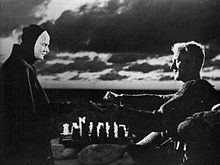 The Seventh Seal (1957), directed by Ingmar Bergman. The iconic scene of Death and Antonius Block in a chess game
The Seventh Seal (1957), directed by Ingmar Bergman. The iconic scene of Death and Antonius Block in a chess game
- Entr'acte (1924), a short Dadaist film by René Clair
- Casablanca (1942), One of the main characters, Rick Blaine (played by Humphrey Bogart), replays a game
- The Seventh Seal (1957), centered around a game of chess between a medieval knight and the personification of Death
- From Russia with Love (1963), based on the Ian Fleming novel of the same name, mentioned above
- 2001: A Space Odyssey (1968), features a game of chess played between the HAL 9000 computer an astronaut, Frank Poole (see Poole – HAL 9000)
- The Chess Players (1977), one of the subplots tells the story of two men obsessed with shatranj
- Mystery of Chessboxing (1979)
- Blade Runner (1982), the replicant Roy Batty and his creator Eldon Tyrell play a game of chess (based on the Immortal Game)
- Dangerous Moves (1984), about two men competing in the World Chess Championship Games
- Mighty Pawns (1987)
- Knight Moves (1992), about a chess grandmaster who is accused of several murders
- Searching for Bobby Fischer (1993), based on the life of Joshua Waitzkin
- Fresh (1994)
- The Shawshank Redemption (1994)
- Geri's Game (1997), an animated short film about a man who adopts two personalities to play chess with himself
- The Luzhin Defence (2000), based on the Nabokov's book The Defense mentioned above
- X-Men (2000) and X-Men: The Last Stand (2006)
- The Chronicles of Riddick (2004) briefly features prison guards playing chess against mercenaries, using live ammunition for pieces
- Knights of the South Bronx (2005), about a teacher who helps students at a tough inner-city school to succeed by teaching them to play chess
- Revolver (2005)
- Queen to Play (2009)
- Bobby Fischer Against the World (2011) An HBO original documentary directed by Liz Garbus premiered on June 6, 2011. The ninety-minute documentary explores the complex life of the troubled genius.[14]
Series
- Noggin the Nog series. The characters' design is inspired by the Lewis chessmen[15]
- Several episodes of the Star Trek series (since 1966) features a Tri-Dimensional chess variant
- The Prisoner (1967–1968) features outdoor chess using people as pieces
- Land of the Giants (1968–1970). The season two episode "Deadly Pawn" features the castaways as chess pieces in a game for their lives.
- Doctor Who serial The Curse of Fenric (1989) features chess as a theme, both the physical game and as a metaphor for the events of the story.
- Twin Peaks (1990–1991)
- The X-Files series, in "The End" episode (1998)
- Last Exile (2003), an anime series. All the episodes are named after chess-related terms (see the list of episodes)
- Code Geass (2006–2007), an anime series
- "The Jerk" (2007), episode of House, about a prodigy with behavioral problems
- Terminator: The Sarah Connor Chronicles (2008–2009) – the origin of the Skynet organization is a computer chess program; chess tournament is featured in season one episodes
- Law and Order: Special Victims Unit series, in the "Hothouse" episode of season ten (2009), in which a young genius is seen obsessing over a chess game
- The Wire, Dee uses the game of chess to explain the drug trade to Bodie and Wallace.
In painting
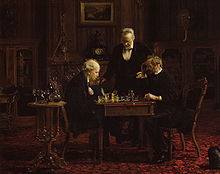 The Chess Players by Thomas Eakins (1911)
The Chess Players by Thomas Eakins (1911)
- I Giocatori di Scacchi (The Chess Players) (c.1590) by Ludovico Carracci
- Arabes jouant aux échecs (Arabs Playing Chess) (1847) by Eugène Delacroix
- Les Joueurs d'échecs (The Chess Players) (1863) by Honoré Daumier
- The Chess Players (1876) by Thomas Eakins
- La famille du peintre (1911) by Henri Matisse
- Portrait de joueurs d'echecs (Portrait of Chess Players) (1911) by Marcel Duchamp
- Femme à côté d'un échiquier (1928) by Henri Matisse
- Super Chess (1937) by Paul Klee
In video games
- Killer7 (2005)
- Deadly Premonition (2010)
Other
- Checkmate, a ballet by the composer Arthur Bliss
- Chess, a musical by Tim Rice and Björn Ulvaeus and Benny Andersson of ABBA
References
- ^ a b c d Litmanowicz (1974), p. 13
- ^ Gamer, Helena M. (1954). "The Earliest Evidence of Chess in Western Literature: The Einsiedeln Verses". Speculum 29 (4): 734–750.
- ^ Sonja Musser Golladay (2007). "Los Libros de Acedrex Dados E Tablas: Historical, Artistic and Metaphysical Dimensions of Alfonso X’s Book of Games". University of Arizona. http://etd.library.arizona.edu/etd/GetFileServlet?file=file:///data1/pdf/etd/azu_etd_2444_1_m.pdf&type=application/pdf. Retrieved 6 August 2010.
- ^ a b "Experts link Leonardo da Vinci to chess puzzles in Renaissance treatise". Winnipeg Free Press. 14 March 2008. http://www.winnipegfreepress.com/historic/32762994.html. Retrieved 4 August 2010.
- ^ Raymond Keene (10 March 2008). "Renaissance chess master and the Da Vinci decode mystery". The Times. http://www.timesonline.co.uk/tol/life_and_style/court_and_social/article3523718.ece. Retrieved 4 August 2010.
- ^ Litmanowicz (1974), p. 11
- ^ Litmanowicz (1974), p. 12
- ^ a b "Elenco romanzi e racconti sul gioco degli scacchi [List of novels and short stories on chess]". Terni Scacchi. http://www.terniscacchi.com/scacchi-scuola/scacchi-elenco-romanzi-racconti.htm. Retrieved 2 August 2010. (Italian)
- ^ a b Litmanowicz (1974), p. 14
- ^ Roesch vs Willi Schlage (1910) in chessgames.com
- ^ Tim Krabbé. "Open chess diary 1-20 (entry 3)". Tim Krabbé's blog. http://www.xs4all.nl/~timkr/chess2/diary_1.htm. Retrieved 4 August 2010.
- ^ Harold C. Schonberg (8 May 1998). "Does Anyone Make a Bad Move In 'Chess'?". New York Times. http://query.nytimes.com/gst/fullpage.html?res=940DE7D9163EF93BA35756C0A96E948260. Retrieved 2008-04-27.
- ^ Arthur C. Clarke. "Quarantine". IBM. http://www.research.ibm.com/deepblue/learn/html/e.8.2.html. Retrieved 2 August 2010.
- ^ hbo.com
- ^ "The Saga of Noggin the Nog". BFI Screenonline. http://www.screenonline.org.uk/tv/id/562377/index.html. Retrieved 31 July 2010.
Further reading
- Litmanowicz, Władysław (1974). Dykteryjki i ciekawostki szachowe [Chess trivia and anecdotes]. Warsaw: Sport i Turystyka. pp. 11–27. (Polish)
External links
- Collection of 310 chess paintings
- Chess In Art (Streatham and Brixton Chess Club)
- McClain, Dylan (May 22, 2009). "Chess on Film". GAMBIT (New York Times). http://gambit.blogs.nytimes.com/2009/05/22/chess-on-film/. Retrieved 2009-05-24.
- "Elenco romanzi e racconti sul gioco degli scacchi [List of novels and short stories on chess]". Terni Scacchi. http://www.terniscacchi.com/scacchi-scuola/scacchi-elenco-romanzi-racconti.htm. Retrieved 2 August 2010. (Italian)
Categories:- Chess history
- Films about chess
- Arts-related lists
- Chess lists
Wikimedia Foundation. 2010.

